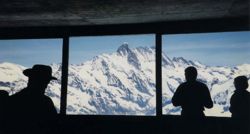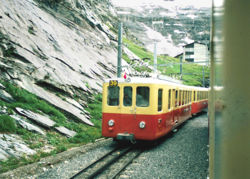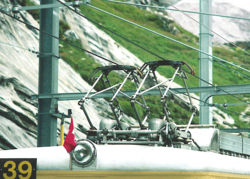Jungfraubahn
The Jungfraubahn (JB) is an 1 m (3 ft 33⁄8 in) gauge rack railway electrified at 3-phase 1,125 volts, which runs 9 kilometres from Kleine Scheidegg to the highest railway station in Europe at Jungfraujoch. The railway runs almost entirely within a tunnel built into the Eiger and Mönch mountains and contains two stations in the middle of the tunnel, where passengers can disembark to observe the neighbouring mountains through windows built into the mountainside.

The JB is under the management of the Jungfraubahn Holding company, which also comprises the Wengener Alp Bahn (WAB) which links to the JB at Kleine Scheidegg and has two routes down the mountain, to Lauterbrunnen and Grindelwald, from where the Berner Oberland Bahn (BOB) connects to the Federal Railways at Interlaken.
History
Starting from approximately 1860 there were many different plans for a mountain railway on the Jungfrau, which failed due to financial problems. In 1894, the industrialist Adolf Guyer-Zeller received a concession for a rack railway, which began from the railway station of the Wengernalpbahn (WAB) at Kleine Scheidegg, with a long tunnel through the Eiger and Mönch up to the summit of the Jungfrau. In 1896 construction began. The construction work preceded briskly. In 1898 the Jungfraubahn opened as far as the Eigergletscher station, at the foot of the Eiger. But it wasn't until February 21, 1912, sixteen years after works commenced, when the tunneling crew finally broke through the glacier in Jungfraujoch. The station at Jungfraujoch was inaugurated on August 1, 1912.
Rolling Stock
Since most of the railway is inside a tunnel, it was designed to run with electricity since conception. The latest rolling stock consists of twin units motor-coaches carrying 230 per train and capable of 27km/h on steepest ascent.
Main Characteristics
| Altitude of top station above Sea Level | 3454 m |
|---|---|
| Difference in height | 1393 m |
| Operational length | 9.3 km |
| Gauge | 1.0 m |
| Cog rail type | Strub |
| Steepest gradient | 25% |
| Smallest curve radius | 100 m |
| Tunnels | 3: longest 7122 m, shortest 110 m. 80% of length of the entire railway. |
| Power system | 3-phase 50Hz 1125Volt |
See also
- Mountain railway
- Rail transport in Switzerland
- Jungfrau is German for virgin; however the Jungfraubahn has nothing to do with Virgin Trains
External links
cs:Jungfraubahn de:Jungfraubahn fr:Chemin de fer de la Jungfrau it:Ferrovie della Jungfrau ja:ユングフラウ鉄道


